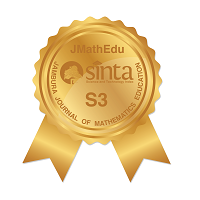Pengaruh Penggunaan Media Berbasis Information and Communication Technology (ICT) terhadap Hasil Belajar Siswa pada Materi Dimensi Tiga
Abstract
Keywords
Full Text:
PDFReferences
R. Resmawan, "Hubungan antara Pesepsi Mahasiswa terhadap Keterampilan Dosen dalam Mengelola Kelas dengan Hasil Belajar Mahasiswa Jurusan Pendidikan Matematika" J. Euler, vol. 2, no. 2, pp. 129-134, 2014.
H. Uno, Teknologi Komunikasi & Informasi Pembelajaran, Jakarta: Bumi Aksara, 2010.
A. Arsyad, Media Pembelajaran, Jakarta: PT Rajagrafindo Persada, 2009.
V. Damopolii, N. Bito, and R. Resmawan, "Efektivitas Media Pembelajaran Berbasis Multimedia pada Materi Segiempat" Algoritm. J. Math. Educ., vol. 1, no. 2, pp. 74-85, 2019.
B. Williams and S. Stacey, Using information technology. London: united kingdom, 2013.
B. DePorter, M. Reardon, dan S. Nourie, Quantum Teaching: Mempraktikkan Quantum Learning di Ruang-ruang Kelas, Bandung: Kaifa, 2010.
A. Suratman, R. Rakhmasari, and D. Apyaman, "Pengaruh Model Pembelajaran Berbasis TIK Terhadap Hasil Belajar Matematika dan Motivasi Belajar Matematika Siswa" J. Analisa, vol. 5, no. 2, pp. 41-50, Jun. 2019.
M. F. Rohim, and M. Zahri, "Pengaruh Model PAKEM TIK pada Materi Trigonometri Terhadap Kemandirian Belajar Siswa" J. Elektronik Pembelajaran Matematika, vol. 5, no. 2, pp. 121-130, Sept. 2018.
Asy'ari, and Gunawan"Pembelajaran Berbasis TIK dengan Assessment For Learning (AFL) Ditinjau dari Kemampuan Spasial Siswa Kelas VIII SMP Negeri Se-Kota Banjarmasin" Math Didactic: J. Pendidikan Matematika, vol. 3, no. 3, pp. 199-209, Dec. 2017.
I.M. Rusmana"Efektivitas Penggunaan Media ICT dalam Peningkatan Pemahaman Konsep Matematika" J. Formatif, vol. 2, no.3, pp. 198-205, 2012.
Masduki and A. G. Nugroho, " Pembelajaran Matematika dengan Media Berbasis Komputer Ditinjau dari Aktivitas Belajar Siswa" in Prosiding Seminar Nasional Penelitian, Pendidikan dan Penerapan MIPA, 2011, pp 159-163.
S. Arikunto, Prosedur Penelitian Suatu Pendekatan Praktek Edisi Revisi VI, Jakarta: Rineka Cipta, 2006.
S. Subari, "Penggunaan Hot Potatoes Dalam Pembelajaran (e-Learning), "2008. [Online]. Available: http://subari.blogspot.com/2008/08/penggunaan-hot-potatoes-dalam.html. [Accessed: 16-Nov-2019]
DOI: https://doi.org/10.34312/jmathedu.v1i1.5376
Refbacks
- There are currently no refbacks.
Copyright (c) 2020 Jambura Journal of Mathematics Education (JMathEdu)

This work is licensed under a Creative Commons Attribution-NonCommercial 4.0 International License.
Jambura Journal of Mathematics Education has been indexed by:
EDITORIAL OFFICE OF JAMBURA JOURNAL OF MATHEMATICS EDUCATION |
 | Department of Mathematics, Universitas Negeri Gorontalo Jl. Prof. Dr. Ing. B. J. Habibie, Moutong, Tilongkabila, Kabupaten Bone Bolango, Gorontalo 96554, Indonesia |
 | Email: [email protected] |
 | +6285255745923 (Call/SMS/WA) |
 | Jambura Journal of Mathematics Education (JMathEdu | eISSN: 2721-7477) by Department of Mathematics Universitas Negeri Gorontalo is licensed under a Creative Commons Attribution-NonCommercial 4.0 International License. Powered by Public Knowledge Project OJS. |



















